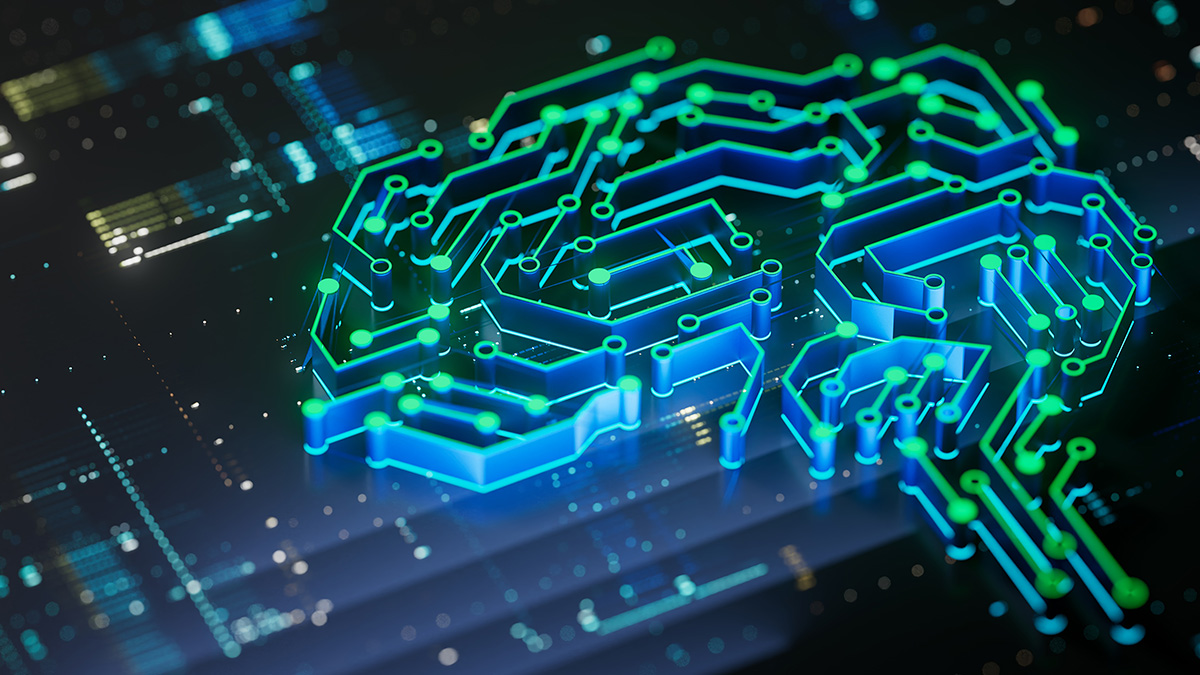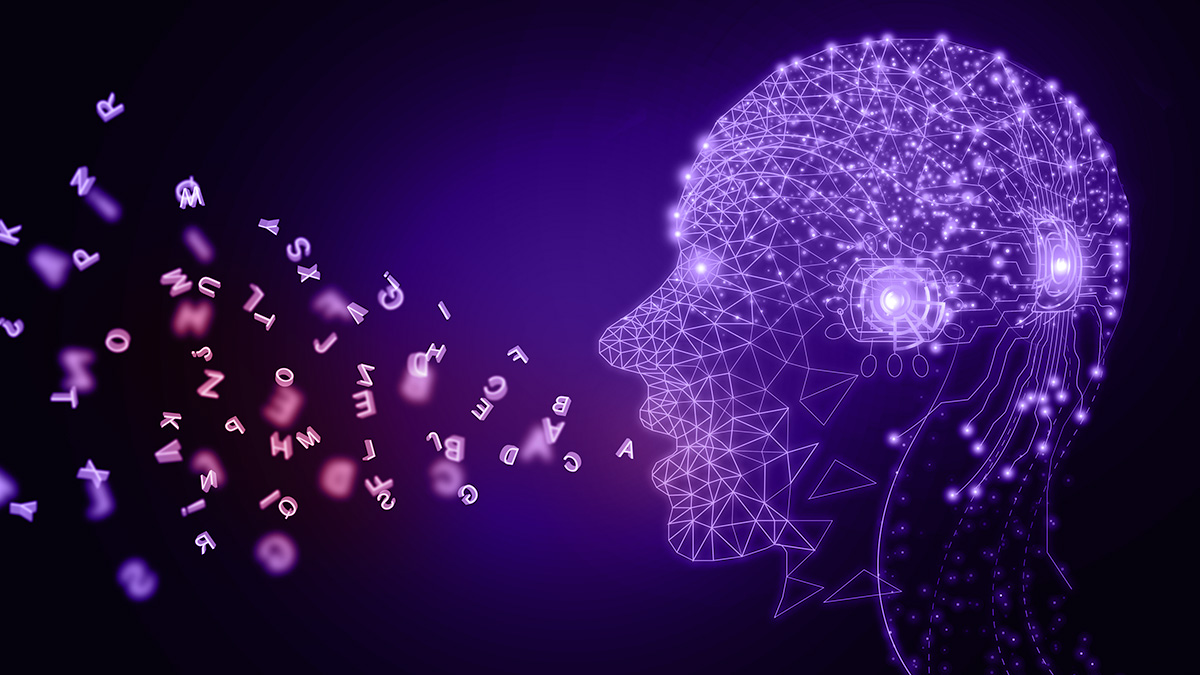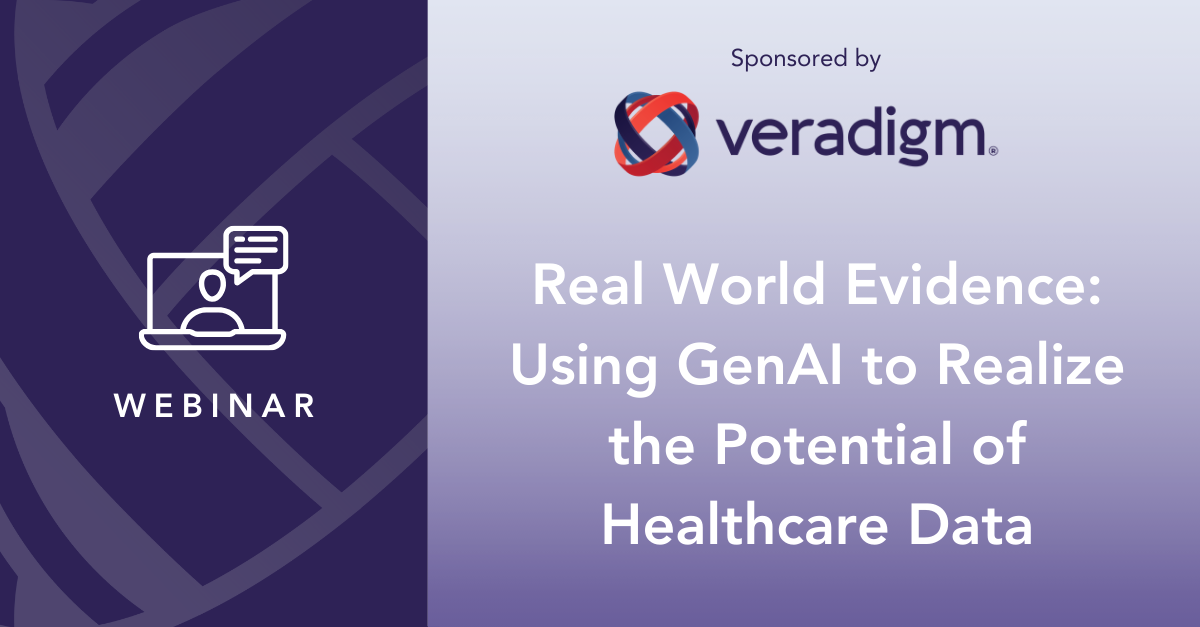In the past several decades, there has been an explosion in the development of artificial intelligence (AI) technology, catapulting numerous industries into an era of rapid changes. The swiftly advancing and developing technology promises to introduce even more change, particularly in healthcare. Forecasters predict that AI in healthcare will grow from its estimated 2023 worldwide market value of $19.27 billion to $187.7 billion by 2030.
The evolving role of AI in the healthcare industry—and its expanding potential to deliver transformative benefits to providers, patients, and payers—is a key area of focus for Veradigm. That’s why we have compiled this in-depth guide to AI: what it is, AI’s role in healthcare, AI’s current and developing healthcare applications, benefits and challenges, ethical considerations, and more.
The concept of AI has existed since the 1950s, when it was first defined as a machine’s ability to perform a task that would have otherwise required human intelligence. Since then, this broad definition has been refined to cover the simulation of human intelligence and problem solving, including a range of capabilities that is constantly expanding as new technologies are developed. AI programming often focuses on simulating cognitive skills based on those of the human brain, such as learning, reasoning, problem solving, perception, and language comprehension.
AI is often classified by intelligence and is generally divided into 2 broad categories: weak AI (most existing AI systems) and strong AI (theoretical future AI systems).
Weak AI, or Artificial Narrow Intelligence (ANI), includes AI systems trained to perform specific tasks or solve specific problems without being explicitly programmed for those tasks or problems. ANI excels at performing its specifically trained functions but is limited to those specific tasks; it’s unable to generalize beyond its defined domain.
ANI drives most of the AI we see in use today. ANI is used for tools such as:
Each of these systems demonstrates the strength of this class of AI’s ability to perform well-defined tasks via analysis of large datasets and the use of specialized algorithms—although they lack the more adaptable intelligence of human cognition. Although this category is often called “weak AI,” “narrow” may be a better descriptor because this type of AI can often outperform humans at their specific tasks.
Strong AI, or Artificial General Intelligence (AGI), is still a hypothetical concept. This type of AI describes a machine that can understand and perform various tasks based on accumulated experience. It demonstrates intelligence equal to or surpassing human intellect and can think and reason like the human brain.
Like humans, AGI could theoretically understand any intellectual task, consider it abstractly, learn from experience, and use its accumulated knowledge to solve new problems. AGI would create a self-aware machine with consciousness and the ability to plan for the future.
Today, AI includes multiple functional areas, which tend to have differing and sometimes overlapping applications: Expert Systems, Machine Learning (ML), Speech Recognition, Natural Language Processing (NLP), Computer Vision, and Generative AI.
Expert systems are a type of AI that uses knowledge and reasoning to solve complex problems within specific knowledge domains. They are rule-based systems that must be created by experts in their particular knowledge field. As rule-based systems, they can mimic human expertise within that field but cannot function outside the field’s boundaries.
Machine learning (ML) is a type of AI that enables machines to analyze large datasets to learn from data and recognize patterns without explicit programming. ML systems need to be “trained” using large amounts of data, but this training allows the system to respond to future data by making predictions and decisions. Facebook’s news feed, which uses ML to personalize individuals’ feeds, is a well-known example of a system utilizing ML.
There are 3 main types of ML algorithms that are used to train systems:
Deep learning is a subset of ML that uses algorithms incorporating artificial neural networks modeled on the human brain’s structure and functioning. The multiple layers of a deep learning system enable ML at scale, unsupervised learning that automates the identification and extraction of features from large, unlabeled, unstructured datasets. The ability of deep learning technology to learn to recognize highly complex patterns using AI means that it is often used in image recognition, natural language processing (NLP), and speech recognition.
Speech recognition is an application of ML specifically focused on converting spoken language into text or commands. Speech recognition AI provides the capacity for machines to interact with users via their spoken language.
Natural language processing (NLP) focuses on the ability to understand, interpret, and generate human language. Spam detection is one of the earliest applications of NLP. More recent approaches to NLP utilize ML and deep learning (a subset of ML) to accomplish tasks such as text translation and even sentiment analysis, which is the analysis of text to identify whether its tone is positive, negative, or neutral.
Computer vision describes AI that enables machines to interpret visual information from images or video data. This technology allows computers to “see” by capturing and analyzing visual information. It is used in a wide range of applications, ranging from signature identification to image analysis.
Generative AI is a fast-emerging type of AI used to generate text, images, or audio from users’ text prompts. Generative AI is also adept at summarizing information from websites and other documents. This type of AI is being used extensively for content generation, such as photorealistic art and email responses.
As seen in the previous section, artificial intelligence (AI) is not a single technology but a collection of technologies—many of which are already being used by payers, providers, and life sciences companies. There are multiple types of AI with clear applications in healthcare.
Rule-based expert systems are used in healthcare to apply AI knowledge and reasoning to complex problems, such as assisting patient diagnosis. Based on a series of “if-then” rules, expert systems have been widely used in healthcare for clinical decision support over the past several decades and are still widely used today. This type of AI is often included with EHR systems to supply physicians with clinical decision support.
Expert systems are created by human experts and knowledge engineers who construct rules in the specific knowledge domain. These systems excel within their designated knowledge domain, automating decision-making by codifying a patient’s medical history, symptoms, and test results based on predefined rules. Within that knowledge domain, they can save time and improve diagnostic accuracy.
However, expert systems start breaking down if the number of rules becomes too great or if the rules conflict. If the knowledge domain changes, updating the rules can be difficult and time-consuming. In addition, these systems tend to have difficulty with scenarios that fall outside their established rules and difficulty handling uncertain or conflicting information. As a result, rule-based expert systems are slowly being replaced by approaches utilizing ML algorithms to interpret data.
One of the most common forms of AI in healthcare, ML works by “training” algorithms using large datasets such as databases of patients’ health records or medical images. Using these large datasets, algorithms are trained to create models that perform tasks such as categorizing information, predicting outcomes, and more. ML operates without explicit instructions or programming, analyzing large datasets to detect patterns and make predictions. Because of this, the more data used to train ML algorithms, the more accurately they can make predictions based on new data inputs.
ML algorithms use several techniques for acquiring knowledge:
Deep learning, a more complex subset of general ML, focuses on training artificial neural networks inspired by the human brain’s structure and functioning. Deep learning utilizes multilayer neural networks, enabling it to identify and extract relevant features from raw data without explicit programming. Deep learning algorithms are characterized by performance superior to that of general ML.
Deep learning is also used to predict molecular interactions, which can assist in drug development, identification of drug targets, precision medicine, personalized healthcare plans, and predictive analytics.
In healthcare, deep learning is increasingly used for speech recognition, freeing clinicians from manually entering EHR notes, as well as clinical decision support systems.
Natural Language Processing (NLP) is another important form of AI in healthcare. It uses AI to process human language for tasks such as speech recognition and text translation. Current approaches to NLP are primarily based on ML and deep learning.
NLP uses 5 fundamental techniques, all of which have healthcare applications:
Deep learning has become critically important for medical imaging analysis, where the algorithms in deep artificial neural networks are achieving new levels of accuracy in image recognition. This is an area where AI often surpasses the abilities of human experts. Deep learning algorithms can compare medical images such as CT scans, MRIs, or pathology slides to hundreds of thousands of images in the database and identify early stages of diseases, increasing diagnostic speed and accuracy and enhancing early detection.
Deep learning algorithms' capability to increase diagnostic speed and accuracy often stems from their ability to perceive details beyond what can be detected by the human eye. This facilitates the detection of potentially cancerous lesions and other relevant features from radiological imaging data, identifying patterns and features that may not be visible to the human clinician but can be recognized by algorithms. Deep learning is particularly useful for AI-based decision-making in situations where experts often disagree, such as identifying pulmonary tuberculosis on chest radiographs.
Generative AI is the result of recent leaps in NLP. This AI form can synthesize not only human language but also other data types such as images, audio, and even molecular structures. Although generative AI is best known for software such as ChatGPT and Meta’s Llama, this type of AI is the force behind the recent surge in virtual online health assistants and chatbots for AI-powered patient support and communications. In healthcare, these AI-powered tools can interact with users and respond to their queries by providing relevant information or performing desired tasks. They are used for customer support, retrieving information, and more.
Robotics, where a physical robot is enhanced with an integrated AI system, is becoming increasingly important in healthcare. Robots are augmented with AI capabilities to extend the capabilities of healthcare professionals. In surgery, robots help improve surgeons’ precision and dexterity, enabling them to perform complex procedures with greater control and accuracy. They can enhance the surgeon’s ability to see during procedures and facilitate minimally invasive techniques. Robots in healthcare help improve patient outcomes in a variety of settings.
Robots are also being used in rehabilitation and caregiving settings. In these settings, robotic devices can provide targeted patient assistance, monitor patient progress, and use real-time data to adjust patient therapy.
Robotic process automation (RPA) does not actually involve robots but refers to computer programs that rely on a set of business rules to automate repetitive and rule-based administrative tasks. RPA is commonly used in healthcare to streamline administrative and financial processes, freeing human resources for other, more critical activities that can only be performed by a human. This allows practices to utilize PRA to improve both the patient experience and their organization’s daily operations.
Compared to other types of AI, RPA tends to be relatively inexpensive, easy to program, and transparent in the steps it takes to accomplish tasks.
Each type of AI has unique capabilities and benefits, ranging from data analysis to clinical decision support to streamlining administrative processes. AI’s broad swath of applications is transforming the healthcare industry, improving outcomes for both patients and providers.
AI technologies currently have 4 primary application areas in healthcare:
Let’s take a closer look at applications in each of these 3 areas.
Rule-based expert systems and their ability to help with disease diagnosis and treatment have been at the core of AI in healthcare for the past 50 years. Early rule-based systems helped clinicians with disease diagnosis and treatment; however, they were not significantly more accurate than human physicians and were not wholly accepted in clinical practice. These systems have greatly improved in recent years. Today, they are used for clinical decision support, using patient symptoms and medical histories to diagnose diseases and provide treatment recommendations.
Rule-based expert systems incorporated into EHR software are widely used today but are generally less precise than ML-based algorithms. It is also difficult for rule-based systems for clinical decision support to stay up to date with the rapid increase of medical knowledge and novel approaches to care.
Machine learning and deep learning-based AI systems can process large amounts of clinical documentation, identify patterns, and make predictions regarding medical outcomes with greater accuracy than ever before. They enable providers to diagnose diseases more accurately than rule-based systems.
ML and deep learning-based algorithms also excel at analyzing medical images (e.g., X-rays, CT scans, MRIs, and pathology slides), improving both the speed and accuracy of diagnoses. ML-assisted imaging analysis aids in early disease detection, enabling more timely treatment initiation for patients. It also supports clinical decision-making involved in the diagnosis and treatment of cancer.
Medical imaging is an area where AI can surpass human experts due to its ability to detect lesions, patterns, and other features beyond what can be perceived by the human eye—improving the accuracy and timing of diagnosis. For instance, researchers in Lithuania developed an AI algorithm capable of predicting the onset of Alzheimer’s disease by analyzing MRI brain scans with an accuracy greater than 99%. Ultimately, these capabilities can help improve treatment outcomes for patients in multiple areas.
Natural language processing (NLP) also has many healthcare applications. For example, applying NLP to medical records allows clinicians to extract useful patient information, which can assist in more accurate diagnosis of the patient’s condition. NLP is also used to identify relevant treatments and medications for individuals, predict potential health risks based on patient health data, and streamline clinical processes.
NLP is used to extract valuable information from unstructured clinical notes, allowing clinicians to automatically extract patient diagnoses, medications, treatment plans, and so on from vast amounts of text data—significantly improving patient outcomes. This capability also enables researchers to aggregate data for research, quality improvement initiatives, and clinical decision support systems.
Combining AI components such as computer vision, NLP, and so on has allowed systems to integrate and analyze comprehensive patient data. This makes it possible for providers to identify previously unknown correlations in healthcare data to help them better diagnose disease and detect subtle changes in patients’ health data that could indicate potential problems. AI is currently used to help identify risk factors and predict disease development by analyzing patient data such as their EHR records, lifestyle information, clinical notes, and genetic information. Early disease detection and identification of risk factors enable early intervention and personalized patient protective measures. The ability to predict disease progression enables providers to create personalized treatment plans based on individual patients’ characteristics.
Treatment optimization algorithms are used to analyze patient treatment responses, outcomes, and clinical guidelines. The results of these analyses are used to determine the most effective treatment options, enhancing the efficacy of treatment decisions—and often simultaneously reducing treatment costs.
Similarly, precision medicine predicts the specific treatment protocols most likely to succeed for an individual patient based on that patient’s data and treatment context. Precision medicine is currently one of the most common clinical applications of AI in healthcare because it helps physicians to predict precisely which treatment procedures are most likely to succeed for specific patients.
For instance, personalized medicine is used to help improve patient outcomes by individualizing cancer treatments. Researchers have found that cancers that appear pathologically similar often respond differently to the same drug treatment; physicians require tools to help them better match patients to the most effective treatments. AI enables clinicians to pair patients with the most effective treatment based on factors such as gene expression or patient metabolic data.
Physical robots integrated with AI systems are used in multiple areas of healthcare. In surgery, they can enhance surgeons’ precision and dexterity, enabling them to perform complex procedures with greater control and accuracy. AI algorithms integrated into physical robots can analyze real-time data to provide surgical guidance and assist decision-making.
Robots are also used in both rehabilitation and caregiver settings, where AI-powered assistive devices provide patients with targeted support to help them regain mobility and independence. Robots can also monitor progress and use real-time patient data to personalize their therapy.
Patient noncompliance—when the patient does not follow their treatment plan or take medications as prescribed—is a significant issue in healthcare. Patient engagement and adherence are often seen as the final barrier between ineffective healthcare and positive health outcomes.
Greater patient participation in their care and well-being can lead to improved patient compliance and an improved patient experience; however, in a recent survey of clinical leaders and healthcare executives, over 70% reported that fewer than 50% of their patients were highly engaged and 42% reported that fewer than 25% of their patients were highly engaged.
Today, clinicians are increasingly addressing these factors through the use of AI to personalize and contextualize patient care. For instance, ML and business rules engines are used to drive interventions such as messaging alerts or providing patients with targeted content. AI-powered applications are also used to track patient adherence patterns, send messages, and provide support. AI algorithms can help clinicians identify barriers to adherence, adjust treatment plans, and enhance patient compliance.
Wearable devices such as smart watches use AI to track and analyze patient data such as blood pressure, activity, and glucose levels. Real-time data transmissions also enhance clinicians’ ability to monitor their patients, both to monitor patient adherence to existing treatment plans and to identify potential health issues in their patients—enabling early intervention and improved disease management.
AI is also changing many administrative aspects of healthcare, revolutionizing tasks such as billing and coding, resource allocation, and overall operational optimization. Automating administrative tasks helps practices save time and money and provides medical professionals with greater autonomy over their workflow processes. AI’s administrative applications can substantially improve efficiency—a boost greatly needed in healthcare when, for instance, the average U.S. nurse spends a quarter of her working hours on regulatory and administrative activities.
The more AI can be used to handle administrative tasks, the more time healthcare professionals have to actually practice medicine—which, in turn, can help minimize the cognitive burden, fatigue, and burnout currently oppressing clinicians.
This is the AI technology most likely to be relevant for administrative applications, where it provides 4 key benefits to users:
RPA increases operational efficiency by automating various repetitive tasks, such as prior authorization, updating patient records, and billing, reducing paperwork and streamlining operations. RPA can reduce manual efforts required from healthcare professionals. It can also improve operational efficiency by automating tasks such as appointment scheduling, where RPA can ensure high volumes of patient appointments are handled promptly and accurately. RPA can transform claims processing with its ability to extract and validate data from insurance claims forms, expediting the reimbursement process. AI can also be used to analyze patient records, practice schedules, inventory, and more to identify ways to streamline workflows.
RPA decreases human error by automating billing and coding processes. By reducing errors, RPA helps practices to decrease claim rejections and expedite reimbursement processes. AI can also help reduce human error by expediting processes such as reviewing patient records, medical imaging, and test results.
RPA saves time for practice staff by automating mundane tasks such as data entry, claims processing, and appointment scheduling—helping free more time for providers to focus on patient care and clinical decision-making. Automating tasks such as appointment scheduling can also help practices to reduce patient wait times. RPA also saves time by enabling seamless data exchange across various systems, eliminating the need for manual data transfer. Similarly, using AI to analyze patients’ medical histories and extract critical information is reshaping medical care today, enabling providers to devote more time to patients.
RPA reduces costs in healthcare organizations of all sizes by helping to streamline processes and improve overall efficiency. By performing tasks such as handling patient appointments, streamlining workflows, and reducing patient wait times, RPA helps practices optimize the use of staff and resources. AI data analysis can also enhance resource allocation to predict future demand and optimize facility planning for optimal resource utilization.
NLP was discussed in clinical applications of AI, but it can perhaps be even more valuable in the administrative arena. NLP can help with 2 main types of tasks:
AI is used to advance healthcare research by analyzing biomedical literature and clinical trial data to generate new insights. One area where these insights are already being used is in drug discovery and development.
Searching for and developing new pharmaceutical agents to treat a specific disease via clinical trials requires years of effort and immense financial investment. However, AI can accelerate the drug discovery process by analyzing vast datasets to identify potential drug candidates and predict how those drugs will react in the body. This can yield a significant reduction in both the cost and time required for clinical trials.
AI delivers numerous benefits when used in healthcare, many of which help to decrease or even eliminate administrative burdens for practices and streamline patient care. These benefits include the ability to:
These benefits allow AI to change how providers care for patients and how patients receive care—impacting both healthcare professionals and their patients.
AI enables providers to diagnose patients’ conditions more quickly and accurately. AI helps providers identify appropriate treatment protocols, clinical tools, and appropriate medications more efficiently. AI also enables providers to design treatment plans tailored to the needs of individual patients.
Providers are also using AI to help document patient encounters in near real-time. This both improves the quality of documentation and helps increase provider efficiency, reducing provider frustration with the time-consuming demands of manual documentation.
All these benefits combine to help counter the current clinician burnout crisis. On average, hospital staff must complete more than a dozen forms for every patient seen; now, new generative AI applications can extract patient data from their medical records to populate required forms. AI also assists with recording notes from patient meetings and improving patient communications.
Patients, of course, benefit from AI because it can help improve health outcomes. However, patients benefit in other areas as well. When AI helps reduce healthcare costs, the savings frequently reach patients. Patients also benefit from healthcare’s increasing use of AI-driven chatbots and virtual health assistants, which can help answer questions and provide information even when other information sources are unavailable. All these factors help improve patient engagement and adherence to their treatment plans—again, potentially improving patient outcomes.
Of course, the use of AI in healthcare brings numerous challenges as well as benefits, challenges ranging from concerns about data privacy to how AI systems will be integrated with practices’ existing IT systems.
Data privacy and security are among the primary concerns related to AI’s use in healthcare. This is because AI systems collect a great deal of patients’ personal health information. Patient data must be protected with adequate security to guard against potential misuse and prevent malicious entities from accessing and exploiting this information.
Patient safety is another critical concern that needs to be addressed before AI can be entirely accepted in healthcare. When AI is used in healthcare, patient safety depends on the accuracy of AI-powered decisions and insights. AI systems not only need to be trained to recognize patterns in health data; they must receive sufficient training to account for the relationships between various diagnoses and treatments.
Patient safety also depends on the elimination of bias from AI algorithms. Bias can be caused by training algorithms using datasets that fail to adequately represent critical gender, ethnic, social, or economic groups. Bias can also result from any human bias in the initial algorithm programming. Only when bias has been eliminated will AI be capable of providing accurate and tailored recommendations to individual patients' needs.
The mechanics of integrating AI into healthcare practices pose another challenge. The first step will be convincing physicians to trust and accept AI-powered decisions. AI systems not only need to demonstrate their ability to provide valuable insights but also convince healthcare providers to adopt these systems into clinical practice. This means clinicians need to determine the best approach to human-AI collaboration. In addition to these hurdles, AI systems must be integrated with practices’ existing IT systems. This process can be expensive and require technical expertise that is difficult to obtain. Once integrated, practices must find ways to ensure the AI systems fully comply with all federal and state regulations.
Some industry experts are concerned that, although AI offers numerous opportunities for time and financial savings through task automation, these potential savings bring with them the risk of eliminating many healthcare jobs. However, another concern may mitigate this risk: that AI cannot reliably replace humans in many situations. That is, AI cannot replicate unique human skills such as creativity, critical thinking, emotional intelligence, or sensitive communication. Rule-based AI systems are likely to have difficulty handling contradictory information and require manual intervention to incorporate new knowledge.
Even when AI has demonstrated greater-than-human accuracy in diagnosing and recommending treatment plans for certain conditions, a recent survey showed that 60% of Americans would be uncomfortable if their provider relied on AI to determine their diagnosis and treatment. In the same survey, 57% of respondents expressed concerns that AI use would worsen the patient-provider relationship, whereas only 38% thought AI would improve patient health outcomes.
AI’s importance in healthcare stems from its potential to create change in multiple areas, from patient care to administrative processes, for payer, provider, and pharmaceutical organizations alike. Leveraging AI permits healthcare systems to optimize and expedite various processes, from diagnostics and treatment planning to administrative tasks. As a result, AI enables healthcare systems to provide patient care more intelligently, quickly, and efficiently while simultaneously reducing associated costs.
AI radically enhances patient outcomes by providing tools for more accurate diagnoses and personalized treatment plans. AI allows clinicians to quickly analyze vast amounts of clinical data, enabling them to identify disease markers and trends that would have previously been overlooked. AI makes big data accessible in medicine, analyzing massive datasets to generate insights that might have been missed. AI can also help clinicians identify treatment protocols, clinical tools, and appropriate drugs more efficiently. Providers are now able to deliver patient care that is personalized, more accurate, and more timely than ever before.
AI is not only reshaping clinicians’ paths to diagnosing, treating, and monitoring patients. Physicians are also using AI technologies to document patient information in near real-time, while practice staff use AI to automate a host of repetitive, detail-oriented tasks previously performed by humans. AI’s use in task automation helps reduce provider frustration with the time-consuming burden of medical documentation. Automation also saves practices time and money, completing tasks more quickly and with fewer errors than its human predecessors.
AI technologies are also generating monumental changes to healthcare research, making it quicker and easier to perform tasks ranging from identifying potential new drugs and drug targets to matching patients to clinical trials to analyzing medical literature. AI is even being used to develop tools for using gene expression data across multiple cancer types to help improve the accuracy of cancer classification.
Although the use of AI in healthcare comes with potential risks, the U.S. currently has no federal regulations that specifically limit AI’s use or provide protections from its potential misuse. There are, however, existing federal guidelines, as well as significant efforts to establish AI governance from all levels of government.
Efforts toward AI governance focus primarily on critical areas such as AI-related:
Without such governance, AI systems pose risks such as biased decision-making, privacy violations, and data misuse. The need for governance is particularly urgent for scenarios where ML-powered algorithms are used for decision-making due to the potential for biases that can result if those algorithms were trained using unbalanced data.
The White House Office of Science and Technology Policy published the “Blueprint for an AI Bill of Rights” in October 2022 to provide businesses with guidelines for implementing ethical AI systems. This document presents a set of principles to help guide the responsible development and use of AI systems, including suggestions for making AI more transparent, less discriminatory, and safer to use. It is expected to guide the evolution of future laws and regulations for AI development and use but is not an enforceable, legally binding document.
The U.S. Chamber of Commerce released a report in March 2023 called for AI regulations. In October 2023, President Biden issued what the technology website TechTarget termed the “most significant domestic federal action” related to AI: the “Executive Order on the Safe, Secure, and Trustworthy Development and Use of Artificial Intelligence.” This executive order builds on the concepts in the “Blueprint for an AI Bill of Rights” to present 8 goals for developing AI regulation. It also tasked the Department of Health and Human Services with a list of actions designed to advance safe, secure, and trustworthy AI.
At the end of 2023, several Congress members reintroduced the Algorithmic Accountability Act, a bill designed to help regulate the use of AI systems. This bill would create protections for individuals affected by the use of such systems for “high-impact” decision-making such as decisions related to diagnosis and treatment of disease. This bill was initially introduced in 2019. Its primary purpose was to require the Federal Trade Commission to create rules requiring companies to test AI-powered systems to help prevent bias and discrimination and to ensure they operated accurately, fairly, and securely.
If this bill passes, it would help ensure that AI systems are no longer exempt from U.S. anti-discrimination laws.
Multiple states have initiated efforts to regulate AI use. California, Connecticut, Texas, and Illinois all have current legislation that aims to encourage innovation in AI while protecting citizens from AI’s potential risks. One example of such a regulation was adopted by the Colorado Division of Insurance in 2023 and was enacted on November 14, 2023. This regulation established requirements for using external consumer data and information sources and algorithms or predictive models using those data sources by Colorado-licensed life insurers.
The goal of this regulation was to prevent Colorado licensed insurers from using such data, algorithms, or predictive models in a way that unfairly discriminated based on information such as an individual’s race, color, national or ethnic origin, religion, disability, sex, sexual orientation, gender identity, or gender expression.
Although the U.S. is still establishing regulations for AI use and development, the European Union (EU) approved its Artificial Intelligence Act in March 2024. This Act is similar to the U.S. “Blueprint for an AI Bill of Rights” in that its primary objective is to require developers creating or working with higher-risk AI applications and systems (such as those used for healthcare applications) to document the use of such systems and mitigate potential risks by putting appropriate safety measures in place. However, unlike the “AI Bill of Rights,” the EU’s Artificial Intelligence Act is a legally enforceable document providing oversight and regulation of high-risk AI systems.
Analysts predict that organizations should expect the arrival, and possibly accelerated arrival, of new laws and regulations for AI use in healthcare over the next 12 to 18 months. As AI regulation increases, business complexity is also expected to increase. Healthcare organizations will likely require new expertise and the ability to regularly update AI-powered systems to assure compliance as laws and regulations change.
The use of AI in healthcare poses many ethical risks and issues that may not apply elsewhere. These include:
ML algorithms, which form the basis for many of the most advanced AI tools, are only as “smart” as the data used to train them. This creates the potential for ML bias, as systems trained using biased data can continue or amplify existing biases, leading to unfair and inaccurate decisions. Similarly, any human present during the training stages can influence the accuracy and functions of the resulting algorithms.
Some researchers have identified race-based biases in existing healthcare algorithms caused by the lack of healthcare data available for women and minority populations. In the May 2022 report on the impact of race and ethnicity in healthcare by Deloitte Insights, researchers called for reevaluating existing clinical algorithms for potential bias regarding patient race or ethnicity.
The American Medical Association (AMA) has identified critical points for the development and use of AI in healthcare to address bias and transparency when using AI for healthcare.
To function properly, AI systems require a broad range of knowledge, including the ability to recognize patterns in medical data and comprehend how different diagnoses and treatments relate to one another. They must also be able to use this information to provide accurate treatment recommendations tailored to individual patients.
When AI-powered tools are used for clinical decision-making, they require human oversight, testing, and mitigation of any detected risks to prevent potentially dangerous errors. Without such oversight, AI diagnoses can be biased by gender, race, or other factors, particularly when the AI is trained using data that is not representative of the population it is being used to treat.
Patient safety and accuracy of diagnoses are also key concerns associated with using AI in healthcare. When AI systems make mistakes in diagnosis and treatment—as they are likely to do—this lack of transparency makes it extremely difficult to establish accountability for errors. This may be why a recent survey of European patients found that patients would be most trustful of AI if it was used in combination with expert judgment from a human clinician rather than if the AI made its decisions independently.
A recent U.S. survey found that the primary concern about AI’s use in healthcare is the potential threats this would create to patient security and privacy. AI systems collect large amounts of personal health information because they rely on analysis of this data to provide accurate diagnoses or personalized treatment recommendations. This makes data privacy especially important, as patient health information has great potential for misuse. AI systems must employ proper security measures to protect sensitive patient health data from possible exploitation.
Research has shown that AI tools can re-identify individuals based on their personal health information, even when that data is theoretically anonymized. In some cases, the AI not only re-identifies the individual patient but can also make fairly accurate guesses regarding the patient’s non-health data.
In addition, healthcare organizations are especially vulnerable to data breaches and ransomware attacks. According to IBM Security’s 2023 Cost of a Data Breach Report, data breaches in the healthcare industry have had an average cost of $10.93 million.
AI in healthcare has also triggered concerns that AI will lead to the automation of many healthcare jobs and the associated loss of those jobs by humans. In a collaboration between Deloitte and the Oxford Martin Institute, researchers suggested that 35% of jobs in the United Kingdom could be automated out of existence by AI advances in the next 10 to 20 years.
Job loss fears extend to certain healthcare administrative occupations, where AI is automating tasks such as data entry and administrative support—reducing the need for human workers in these roles.
However, other studies suggest that, although some jobs may be automated, job losses are likely to be limited by several external factors, such as the growth of the labor market, costs of automation technologies, and regulatory and social acceptance. With these factors, researchers suggest that actual job loss will be 5% or less.
Whatever AI’s future impact on job availability in healthcare, to the knowledge of the study’s authors no jobs have been eliminated so far. They suggest that healthcare positions dealing with digital information—such as radiology and pathology—will be the healthcare jobs most likely to be automated rather than those with direct patient contact.
Even in the positions of radiologist and pathologist, however, AI is predicted to face slow adoption. Even though deep learning algorithms can improve the capacity for diagnosing and categorizing images over a human’s ability, radiologists and pathologists have roles beyond reading and interpreting images. They consult with other physicians to determine the best diagnosis and treatment for a patient. They treat disease and perform image-guided medical interventions, such as targeted radiation therapy and cancer biopsies. They also discuss images, procedures, and results with patients, among other activities.
In addition, radiology AI systems are trained to recognize specific images; each algorithm is trained for a relatively narrow detection task. Thousands of separate detection algorithms would be required to fully identify all potential findings in medical images, of which only a few currently exist.
One of the primary goals for AI’s recent use in healthcare has been to reduce healthcare costs—and AI has already demonstrated its ability to help cut costs in multiple arenas, including healthcare processes, administration, and drug development.
One of the main ways AI adoption in healthcare is reducing healthcare costs is by increasing the speed and accuracy of patient diagnoses. AI also supports improved decision-making in multiple ways. ML algorithms can quickly process large volumes of clinical documentation, identify patterns, and predict medical outcomes more accurately than ever before. AI systems leverage predictive analytics to help providers offer proactive, preventive care.
The technology enables providers to design individualized treatment plans. AI support in these areas combines to improve the quality of patient care as well as patient outcomes. In turn, improving overall patient care leads to cost savings when patients recover more quickly.
Researchers estimate that more than a third of all healthcare spending in the U.S. goes to administration and billing—which is why AI can help cut healthcare costs by automating and streamlining various administrative processes, such as scheduling appointments and processing insurance claims. AI used in billing and coding can help automate multiple steps in the process, which, in turn, helps increase accuracy, decrease errors, and minimize claim rejections. This leads to more timely and accurate reimbursement. AI is also used to enhance resource allocation in healthcare, analyzing data regarding previous use of resources such as staff, equipment, and facility rooms and providing insights that aid optimal resource utilization.
By leveraging administrative AI algorithms, practices can streamline processes and improve overall efficiency—and, in the process, further reduce costs. Reducing administrative burden also allows healthcare providers to focus more on patient care, simultaneously improving operational efficiency and patient experience.
AI technologies are decreasing expenses in the biopharmaceutical industry as well as in the rest of healthcare. Using traditional methods, researchers require 4 to 5 years of preparation before starting the first clinical trial for a new drug candidate. However, AI can accelerate the identification of small-molecule drug candidates, saving years of expensive drug development time. AI can further streamline the drug development process with the ability to match potential drug targets with new molecules, to test their ability to treat and cure diseases. This saves research time and expense, leading to cheaper, better patient care.
AI has already begun to play an essential role in healthcare—a role that promises to become even more critical as AI capabilities continue to advance and grow. AI is positioned to help improve patient outcomes, increase safety, reduce human error, and reduce healthcare costs, among many other benefits.
For instance, ML is the primary capability enabling the development of precision medicine, a much-needed advance in patient care. Deep learning has demonstrated its growing ability to help detect diseases more quickly and provide personalized treatment plans. With rapid advances in the use of AI for image analysis, experts predict that, in the near future, most radiology and pathology images will be examined by AI.
Speech and text recognition are already used for tasks such as capturing clinical notes and patient communications; those areas are expected to continue to grow, enabling providers to spend less time on administrative tasks and more time interacting with and treating patients.
AI is also predicted to integrate more fully with wearable devices, giving providers access to a wide range of real-time patient data to aid with patient diagnosis, monitoring, and treatment.
As AI’s roles expand across healthcare, AI will help providers achieve greater efficiency, greater accuracy in diagnosis and treatment, enhanced analytics for disease prevention, and overall improvements in the ability to deliver patient-centric care.
Grand View Research forecasts that AI in healthcare will be valued at $208.2 billion by 2030, a value many times greater than its 2022 market value of $15.4 billion, while an article in the Future Healthcare Journal predicts that AI will see “limited use” in clinical practice by 2024 and more extensive use by 2029. However, no matter how great the AI healthcare market becomes, it is likely that the use of AI in healthcare will continue to require human interaction. From emotional intelligence to patient empathy to critical reasoning, certain skills are better accomplished by the human intellect than by “1’s” and “0’s”. For that reason, researchers do not expect AI to replace healthcare providers. Instead, AI is expected to support and improve their work sometime in the near future.
Veradigm is dedicated to supporting and encouraging the use of AI to help improve every aspect of healthcare. We are already using AI to bolster the efficiency and efficacy of the solutions we offer—and we are continually looking for new avenues for using AI to improve our products and services.
One Veradigm solution currently powered by AI insights is our Predictive Scheduler.
In a recent consumer survey, respondents identified getting an appointment in a timely manner as their greatest challenge to a positive patient experience. Long appointment wait times are a major impediment to a quality patient experience. They also negatively affect other issues as well, including patient safety and overall practice reputation.
Despite these drawbacks, long appointment wait times are a problem area for many practices. In a recent MGMA Stat poll, 76% of medical practices reported that their patients’ time to appointment had either remained the same or worsened in the past year. Perhaps this is not surprising, given the ongoing difficulties many practices have hiring and retaining critical patient-facing support positions; in another recent MGMA Stat poll, 56% of medical groups reported staffing as their biggest productivity roadblock.1
Meanwhile, numerous other factors are escalating the administrative burdens faced by today’s practices, factors including:
Veradigm’s AI-powered Predictive Scheduler can help practices tackle long appointment wait times and other scheduling issues. Using AI and predictive analytics, the Predictive Scheduler forecasts which patients are likely to have more pressing needs and then generates a schedule that automatically prioritizes those visits while minimizing the impact on scheduled patients. This advanced scheduling solution enables practices to deliver high-quality care, improve patient outcomes, and optimize operational efficiencies.
Overbooked clinicians, last-minute cancellations, high no-show rates, and volatile patterns of daily demand all lead to inefficient use of practice resources, but Predictive Scheduler can drive schedule optimization by using predictive analytics to address common scheduling challenges. Predictive Scheduler evaluates historical visit patterns and uses the results to calculate appropriate overbooking levels to help minimize unused capacity while avoiding excessive wait times—filling openings to expedite urgent cases while creating enough flexibility to prevent clinician overload. By enhancing practice efficiency and helping improve patient care coordination, Predictive Scheduler helps practices boost both productivity and revenue.
Veradigm also offers Robotic Process Automation (RPA) as a solution to automate repetitive rule-based tasks in revenue cycle management, which are typically performed by humans. This increases practices’ productivity and accuracy in performing those tasks.2
Revenue cycle operations are becoming increasingly complex as healthcare shifts toward value-based contracts and as reimbursement models, government requirements, and patient expectations evolve. Despite these changes, many practices continue to rely on error-prone manual processes. At the same time, practices are facing increasing financial challenges. A recent MGMA Stat poll showed that 89% of medical groups’ operating costs increased in 2023, and reimbursement rates are declining steadily. The status quo is not sustainable.1
However, the repetitive and transactional nature of the revenue cycle makes it a perfect target for RPA. For instance, 30% to 40% of healthcare claims result in edits or exceptions that could lead to denials, but RPA could help facilitate claims review, identify issues, and quantify and categorize past denials. Research has shown that RPA can create a 25% to 50% savings in revenue cycle operations by helping to increase efficiency and minimize errors in the revenue cycle.
That’s why Veradigm has utilized RPA to automate rule-based tasks previously performed by humans to answer our clients’ needs for enhanced productivity in revenue cycle management, data extraction, and decision support. We can use RPA to automate processes that include:2
Implementing RPA has provided our clients with outcomes that include higher quality, greater productivity, and decreased costs.
Recently, Veradigm even acquired the successful creator of a leading Healthcare AI platform, ScienceIO. This acquisition provides Veradigm with the ability to leverage the company’s platform to create its own proprietary large language models by using Veradigm’s large-scale, high-quality data sets. We believe this will help to reposition Veradigm as a leader in the healthcare AI market.
Veradigm’s AI Audiences use EHR-based targeting to expand reach, strengthen point-of-care marketing, and drive stronger provider engagement and Rx lift.
Read moreLearn how AI and real-world data help pharma marketers analyze GLP-1 patient journeys, predict adherence and improve engagement in a competitive market.
Read moreDiscover how natural language processing EHR data & large language models transform vital provider notes into actionable insights to enhance patient care.
Read moreDiscover groundbreaking research and AI-powered insights from ISPOR 2025, reshaping health economics, outcomes research & driving life sciences innovation.
Read moreScott Stratton and Ian Maurer, CISSP sit down with Dr. Scott Sigman for a special educational segment on AI technology in clinical practice.
Read moreAI is transforming drug development, clinical trials, and real-world data applications across life sciences with Veradigm's NLP-driven insights.
Read moreSee how EHR data enhances patient care, clinical trials, and research efficiency. Learn how Veradigm helps harness its full potential.
Read moreSee how AI and real-world data (RWD) are transforming healthcare research, clinical trials, and treatment optimization.
Read moreAmbient AI Scribes enhance medical documentation, reduce clinician workload, and improve patient care by streamlining clinical notes and workflows.
Read moreExplore the latest research on GLP-1 receptor agonists for weight loss. Learn about persistence vs. discontinuation outcomes.
Read moreAdvanced technology can help healthcare practices address financial and operational challenges, from workflow automation to revenue cycle management.
Read moreDiscover effective strategies to increase efficiency in your practice. Learn how Veradigm's suite of solutions can help improve the quality of care.
Read moreUnderstand the ethical challenges and benefits of AI in healthcare. Learn how to balance innovation with patient safety, privacy, and equality.
Read moreExplore the transformative impact of GenAI and LLMs on healthcare research. Watch Veradigm's webinar to stay ahead in innovation!
Read moreNew Becker’s Payer Issues Podcast Featuring Veradigm Discusses How Technology is Changing the Landscape for Payers.
Read moreAs part of Veradigm, Koha Health’s services now include advanced support for managing staff, streamlining workflows, ensuring medical coding accuracy, insurance claims submission, and comprehensive reporting. This integration is designed to leverage your existing technology investments and drive meaningful improvements that impact your bottom line. With Veradigm, you gain access to an expanded suite of tools and resources that build a strong foundation for future success. From efficient revenue cycle management to enhanced patient care, Veradigm is committed to supporting your goals now and into the future.
Allscripts transitioned its solutions to the Veradigm brand, including electronic health records, practice management systems, and patient engagement platforms in 2022. Veradigm is a healthcare technology company that drives value through its unique combination of platforms, data, expertise, connectivity, and scale. The Veradigm Network features a dynamic community of solutions and partners providing advanced insights, technology, and data-driven solutions for the healthcare provider, payer, and life science markets.
Former Pulse8 solutions are now part of the Veradigm Payer Analytics portfolio. In addition to delivering complete visibility into the efficacy of your Risk Adjustment, Quality Management, and Pharmacy programs through former Pulse8 solutions like Calcul8, Qualit8, and others, Veradigm offers a broad range of solutions to help Payers meet their goals for supporting high-quality, cost-effective patient care.
Babel Health solutions are now part of Veradigm Payer Analytics, with enhanced Risk Adjustment (RA) submission workflow creating an end-to-end solution for regional health plans and payers. With Veradigm, Babel clients can receive enhanced support with the ability to leverage a truly end-to-end suite of products and solutions. From RA and Quality analytics and reporting, provider engagement tools, and comprehensive submissions solutions, Veradigm is positioned to support your goals now and in the future.
Evalytica platform is now part of the Veradigm Network and is known as Veradigm Real-World Evidence (RWE) Analytics Platform , a powerful self-service analytic platform. This transition allows for the advancement of our RWE Analytics technology, expansion of the platform and improvement of its capabilities, functionality, and reach.














